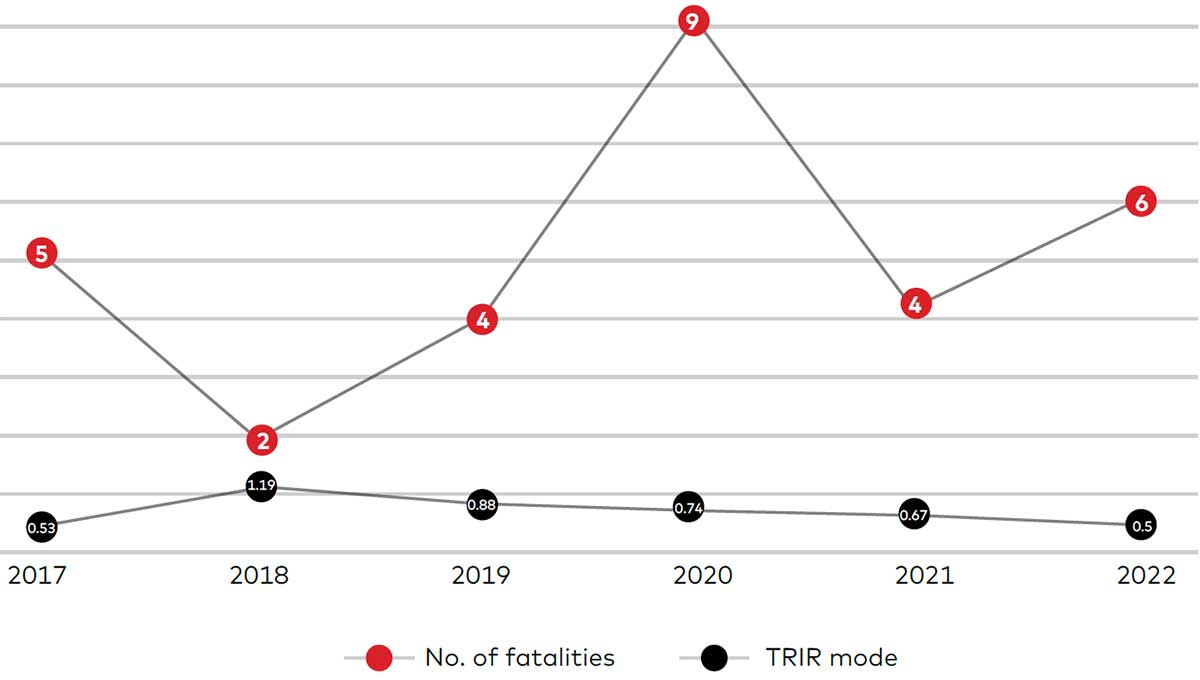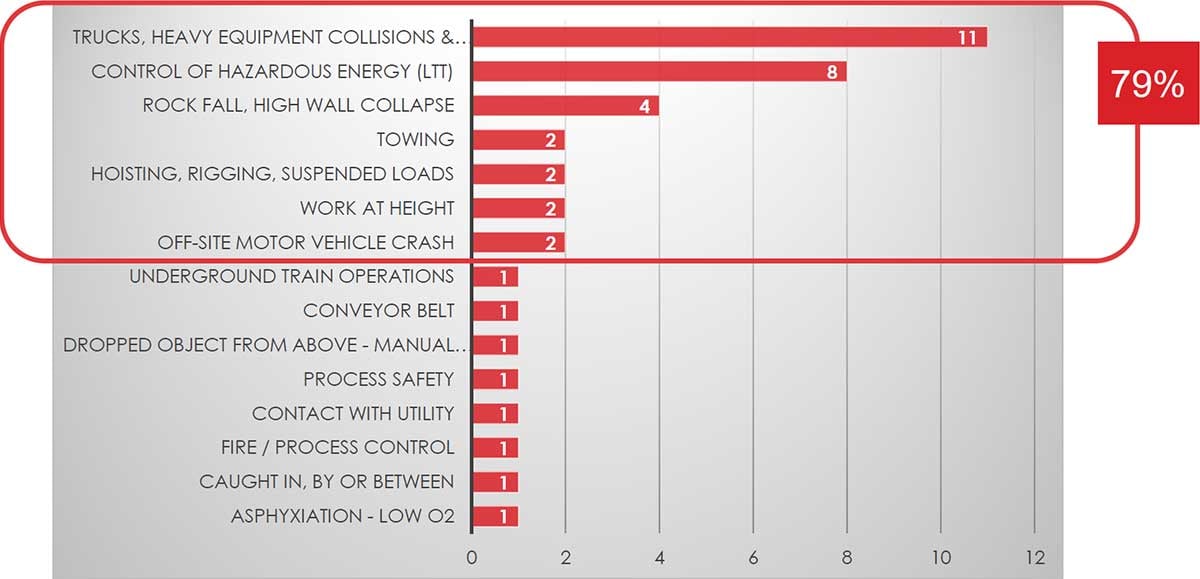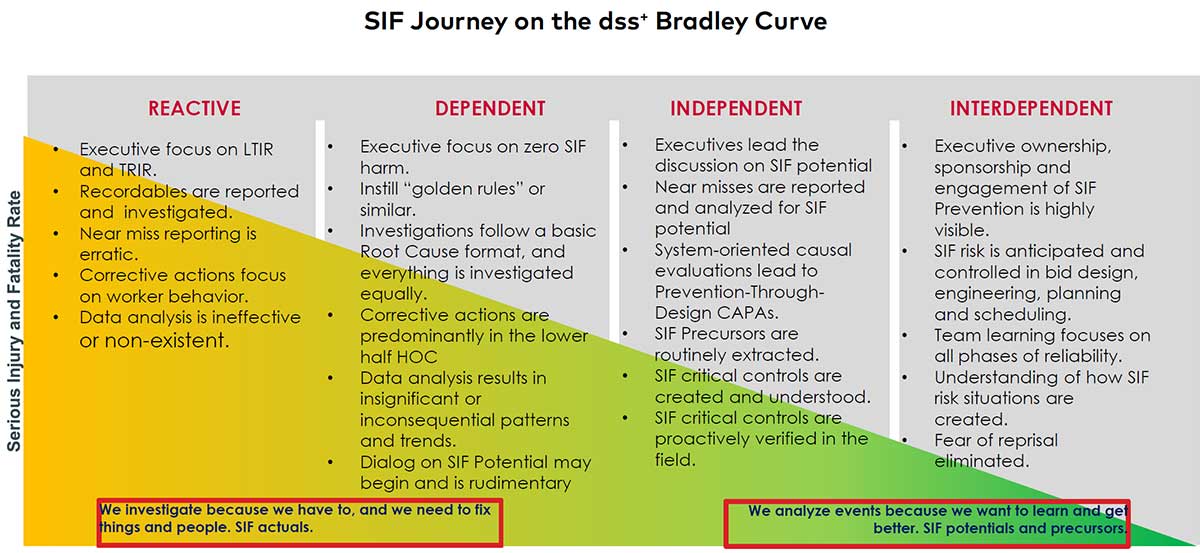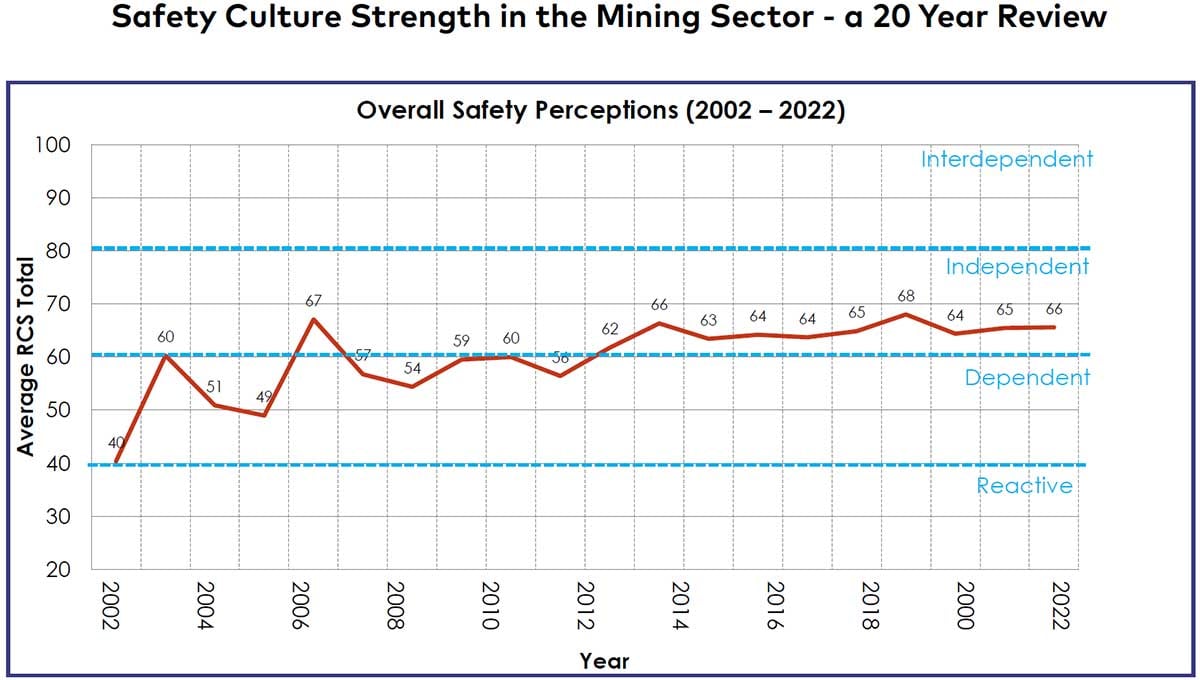How dss+ is navigating Serious Injury and Fatality (SIF) in the Mining industry
Donald Martin shares his knowledge on Serious Injuries and Fatalities (SIF) in the Mining industry and explains his recommendations on preventative measures and continuous learning for organizations. Along with seven participating companies, this paper dives into the work-related fatality experience and the common problems shared within the mining community. This study group was formed to collaboratively share perspectives, practices, and learnings for the benefit of all.

Background
The mining industry sector worldwide is experiencing an ongoing and, in some places, a worsening Serious Injury and Fatality (SIF1) problem.
To study the causes and contributing factors behind this troubling trend, dss+ and seven companies formed a Mining SIF Study Group that worked together for almost two years. The group challenged operating paradigms, tested new approaches and developed recommendations to improve Serious Injury and Fatality (SIF) Prevention strategies.
The seven participating companies from the mining sector provided significant narrative and investigative information on 39 fatal and near-fatal events, ensuring the full context of each situation was well-understood. dss+ led a team of representatives from these seven companies through numerous facilitated exercises over the course of over 24 months to understand the deeper causal and contributing factors connected to these events.
Organizations such as ICMM, MSHA, NIOSH, MSRT, CIM/ICM and Euromines have made significant efforts to understand mining related fatalities and to prescribe preventive measures. All of these organizations have also invited continuous learning and expansion on their respective recommendations. The work-related fatality experience is a common problem shared within the mining community. This study group was formed to collaboratively share perspectives, practices, and learnings for the benefit of all.
Data Analysis
Analysis of 6-year trends
The data from the Mining Study Group shows continuing improvement in recordable injury rates, but random occurrences of fatal accident events.
Mining Study Group Combines SIF Data (n=7 companies)

The study group concluded that recordable injury rates are poor predictors of fatality risk control. The data demonstrates there is no correlation between recordable rates and fatality occurrences.
Analysis of predominant SIF risk situations
23 of the 39 fatal and near-fatal events were attributed to three SIF Risk Situations:
- Truck, Heavy Equipment Collisions, Crashes and Rollovers (on-site)
- Control of Hazardous Energy (Lock Tag Try) Breakdowns
- Rock Fall, Rock Burst, Fall of Ground, High Wall Collapse
SIF Risk Situations - Pareto Analysis (n=39)
Actual potential of SIF situation or outcome
Did this event cause, create or result in a vulnerability to...?

The Study Group advises all mining companies to develop a Pareto analysis specific to their mines and sites to improve understanding of their top SIF risk situations. This analysis will enable a more effective allocation of limited resources (people, time and money).
1 The Mining Study Group uses the terms fatality and SIF interchangeably. This study was driven by fatal and near-fatal events, but the findings and conclusions naturally broaden to overall SIF prevention in the mining sector.
SIF Precursor Extraction and Analysis
dss+ proposed a SIF precursor formula for the study group’s consideration. Each of the 39 fatal and near-fatal events was examined through the three elements of the SIF precursor formula.

Three notable themes emerged from the analysis of SIF Precursor element number 2:
- The only or last available critical defenses (controls) were the behaviors and judgment of the persons involved (described in the chart above).
- Reliance on human behavior to perform flawlessly is prevalent.
- In almost 100% of the events, the tasks performed prior to the fatal or near-fatal event were described as “routine/normal” operations and maintenance activities, versus highly unusual or rarely encountered tasks
Determining SIF-Potential
The study group agreed that determining if SIF-Potential is present in reported events is of paramount importance toward understanding a site’s true vulnerability to experiencing an actual SIF outcome. A process for evaluating reported events, identifying those with SIF-potential, and assigning those SIFp cases for some type of causal analysis is an important feature of an effective SIF prevention system.
Many mining organizations utilize Bow-tie Analysis to analyze SIF Risk, and to inform their opinions on the presence of SIF-Potential. dss+ promotes an evidence-based perspective that the unwanted event occurred because of failure of controls on left side of the bow tie (preventive). Preventive control failures should carry the same weight as the controls that mitigate the severity of consequences of the injury (right side of the bow tie).

It is important for organizations to develop and use consistent logic for determining SIF-Potential. This accuracy is essential to the credibility of the SIF Prevention Program. The Study Group developed a starter template for SIF-potential determination logic, as a tool for others to consider.
Assessing the Presence and Performance of SIF Critical Controls
SIF Critical Controls are generally defined as pinpointed protective requirements/steps that are detectable through direct observation or interview. They are essential toward protecting the life of the person(s) performing the work. The evaluation of SIF Critical Controls in the field is best performed as a binary process – these critical controls either “present or not present” and “performing or not performing”.
The SIF Protection Validation System (SIF-PV) or SIF Critical Control Verification System is a proven method for providing workers and executives with the assurances that critical controls are available and performing when called upon. An effective system will deliver field-based evidence letting everyone know with certainty that miners are fully protected when performing jobs that have SIF risk.
The Study Group identified four cornerstones common to best-inclass SIF-Protection Validation Systems.
- The Approach – how the crew/worker is approached to initiate the conversation makes all the difference in the world.
- The Delivery – a standardized method for guiding the conversation around SIF risk vulnerability will ensure consistency of outcome.
- The Payoff – both the worker/crew and observer walk away from the engagement with higher assurances that everyone is protected from SIF harm and know what to do when they detect any missing or underperforming critical controls.
- Governance – the health of the system is monitored, and data is collected for analysis, trending, and action planning.
The Study Group has deemed SIF-PV systems to be investment worthy, and capable of enabling strong, positive safety climates. SIF-PV checklists for 3 SIF risk situations were built as starting points for other companies to consider.
SIF Metrics
The Study Group expressed a strong preference for establishing a set of SIF metrics as an outcome of this project. The Study Group examined current SIF KPI practices from their companies, as well as SIF metrics from other industry sectors. An expectations framework guided the group toward the development of meaningful leading and lagging SIF indicators. Ultimately, the Study Group agreed that a balanced portfolio of SIF Metrics should be capable of…
- 1. Expressing an organization’s true vulnerability to experiencing SIF events,
- Monitoring the health of the SIF Risk Control system, and
- Measuring the outcomes of SIF Prevention efforts
The Study Group recommended five SIF Metrics and developed definitions and calculations guidance for each metric.
- # of SIF Actuals [SIFa]
- # of SIF Potentials [SIFp]
- %SIF Risk or %SIF Vulnerability
- SIF CAPA Closure %
- % Protected from SIF Harm
These five recommended SIF metrics are intended to drive crucial leadership discussions about essential SIF Prevention activities that drive continuous improvement.
The SIF Culture Maturity Journey on the dss+ Bradley Curve™
Study Group members agreed that companies embarking on an SIF prevention initiative should expect to go through a maturity journey while their SIF prevention system is evolving. As an organization moves from the reactive to the interdependent phase, their SIF journey and their organizational culture matures and move symbiotically. A well-designed and well-executed SIF prevention program is in fact a key driver of a cultural transformation.

dss+ has collected Relative Culture Strength (RCS) scores from the Mining Sector over a 20-year period. Over the last decade, the data clearly shows a plateau, and no organizational movement beyond the mid-point of the independent quadrant.

The Study Group agreed that executive sponsorship is an essential key to organizational understanding and control of SIF risk vulnerabilities. The leadership practices and styles associated with SIF Process effectiveness are known to drive cultural transformation into the interdependent quadrant. More executive attention is necessary for driving significant impacts in SIF prevention.
Key Conclusions and Recommendations
- Low and improving recordable injury rates are inaccurate and unreliable indicators of fatality risk control. This is a trap that is easy for company executives, senior managers, and safety professionals to fall into. The evidence is compelling – special treatment of SIF risk is required to address the SIF problem.
- Determining the presence of SIFPotential in reported events is of paramount importance toward understanding a site’s true vulnerability to experiencing an actual SIF outcome. A process for evaluating reported events, identifying those with SIFpotential, and assigning those SIFp cases for some type of causal analysis is an important feature of an effective SIF prevention system. Customizable, starter templates for SIF-Potential Decision Logic have been developed for others to use.
- Effective use of the SIF Precursor model will drive a more in-depth analysis and understanding of the presence of SIF Risk in the worksite, the pinpoint accuracy of the SIF critical controls needed to fully protect workers, and the reasons behind continuing breakdowns in SIF critical control performance. Analysis of 39 fatal and near-fatal events is provided to serve as an example.
- A Pareto-style analysis of the prevailing SIF Risk Situations will enable organizations to prioritize the assignment of limited resources to conducting SIF-Protection Validations, SIF-Potential causal evaluations, and follow-through on corrective and preventive actions. A Pareto Analysis of the 39 fatal and near-fatal events shows seven SIF Risk Situations comprising 79% of the exposure, with the Top 3 (59%) being… a. Truck/Heavy Mobile Haulage Equipment Collisions, Crashes, and Rollovers while operating on-site b. Control of hazardous energy due to breakdowns in Lock/Tag/Try procedure c. Rock Fall/Highwall Collapse/Rock Burst/Fall of Ground
- The SIF Protection Validation or Critical Control Verification System is an investment-worthy method for providing workers and executives with the assurances that critical controls are available and performing when called upon. Best-in-class systems would be designed around four cornerstones: Approach, Execution, Payoff, and Governance. Customizable, exemplar templates have been developed for three SIF Risk Situations, for others to use.
- SIF metrics can drive desirable organizational focus and level-specific behaviors if they are fit-for-maturity of the organizational culture and fit-for-maturity of the SIF Prevention Program. A well-designed portfolio of SIF KPI’s will enable an accurate understanding of vulnerability to experiencing SIF events, monitor the health of the SIF Risk Control system, and measure the outcomes of SIF Prevention efforts. The Study Group developed five SIF Metrics for consideration and recommends SIF-Potentials and SIF% Vulnerability as compelling leading indicators for adoption by the mining community.
- Executive ownership of SIF risk and sponsorship of SIF risk control initiatives is essential to the success of the mining industry SIF Prevention effort. The links between leadership practices and organizational culture maturity are wellestablished, and this relationship is especially important in SIF Prevention. When SIF discussion is part of the executive agenda, and executives are actively engaged in SIF-prevention related activities, it send clear signals to the organization about the value and priority being placed on SIF risk control.
- Three areas for further research and development were identified by the Study Group. Other interested parties and future Study Groups are encouraged to explore best-practice contributions in…
- Contractor SIF Leadership – going beyond traditional baseline metrics, and exploring executive sponsorship of SIF prevention, operating philosophies on near-miss reporting and use of stop-work authority, and promotion of joint SIF-PV and SIF-p analysis practices.
- Modern Approaches to Incident Investigations – going beyond traditional root-cause-analysis, and movement toward causal learning models, human operating principles, and understanding of how SIF risk situations are created.
- Supporting Evidence for the Value of SIF-Protection Validation Systems – advanced SIF-PV data analysis to build evidence of connection to the prevention of SIF-Actuals.